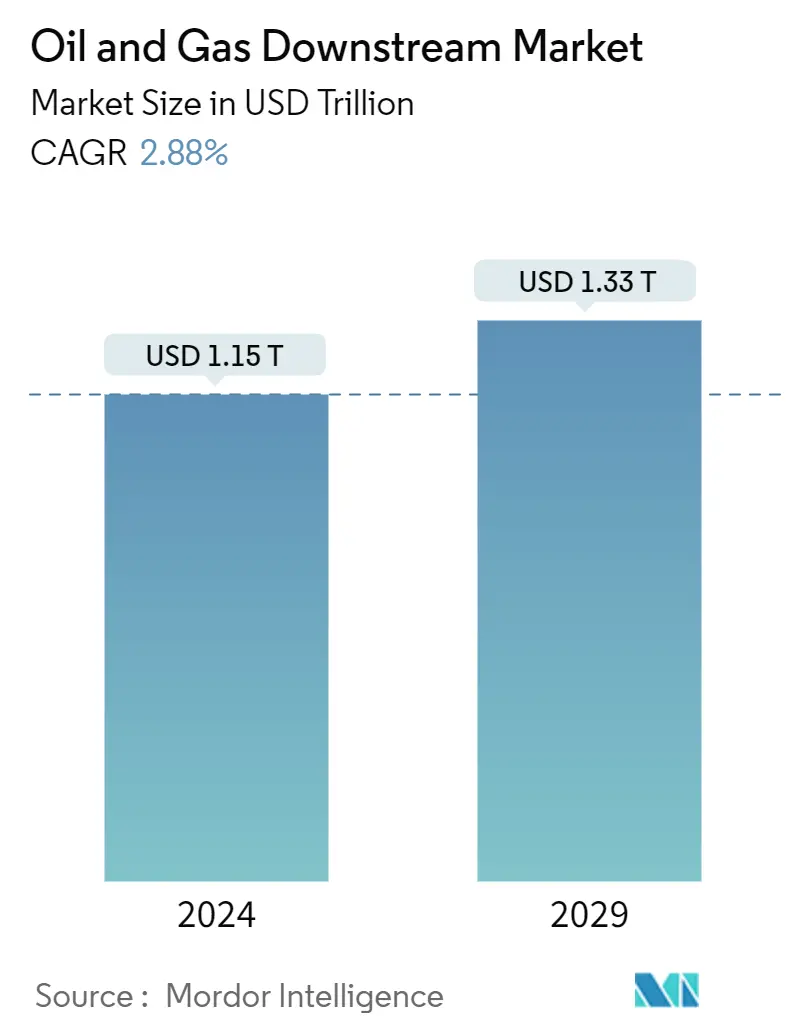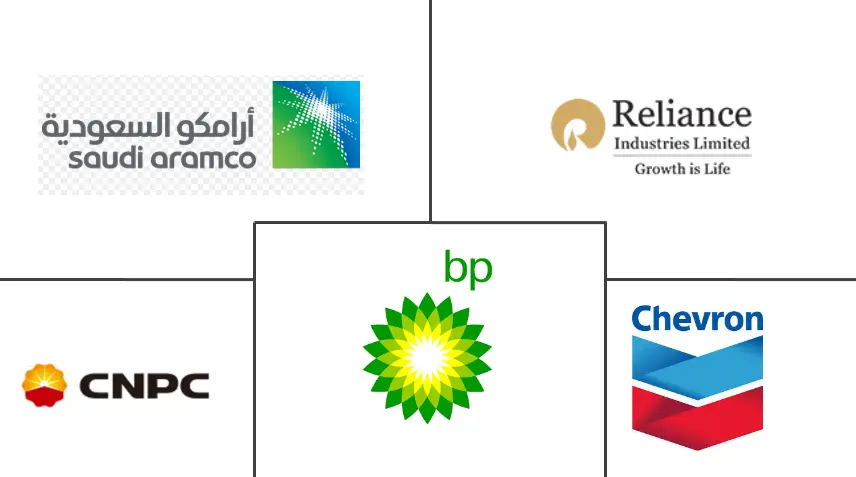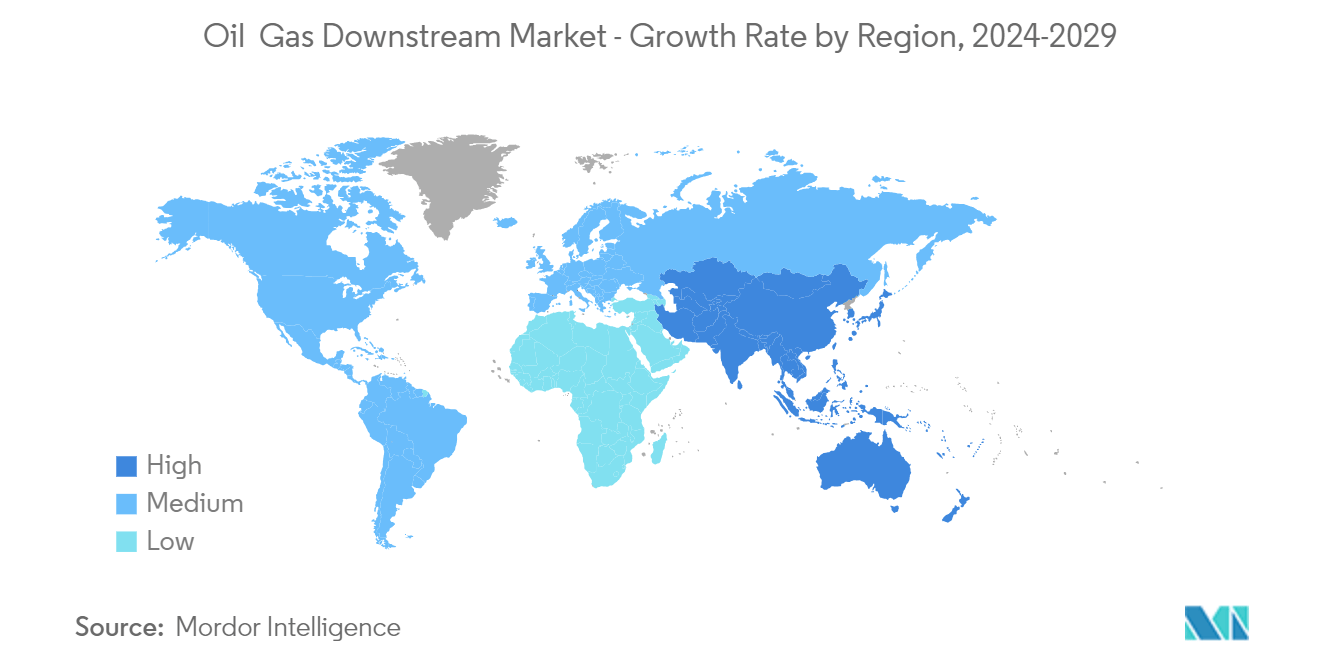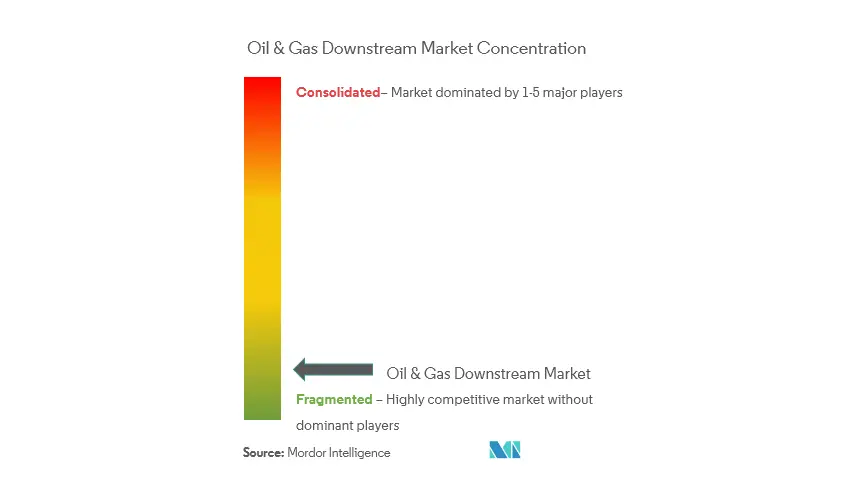Oil & Gas Downstream Market Size

| Study Period | 2019-2029 |
| Market Size (2024) | USD 1.15 Trillion |
| Market Size (2029) | USD 1.33 Trillion |
| CAGR (2024 - 2029) | 2.88 % |
| Fastest Growing Market | Asia Pacific |
| Largest Market | Asia Pacific |
Major Players
*Disclaimer: Major Players sorted in no particular order |
Oil & Gas Downstream Market Analysis
The Oil & Gas Downstream Market size is estimated at USD 1.15 trillion in 2024, and is expected to reach USD 1.33 trillion by 2029, growing at a CAGR of 2.88% during the forecast period (2024-2029).
Over the medium term, factors such as increasing refining capacity across Asia-Pacific and the Middle East and rising industrialization in developing countries are expected to drive the oil & gas downstream market during the forecast period.
On the other hand, the growing share of fuel-efficient vehicles and increasing penetration of electric vehicles in both developed and emerging economies are expected to hinder market growth during the forecast period.
Nevertheless, digitalization and modernization of the refining and petrochemical sectors are expected to reduce refining costs and process losses. This, in turn, is expected to create an opportunity for the market during the forecast period.
Asia-Pacific has dominated the oil & gas downstream market, with the majority of the demand coming from China, Southeast Asia, and India.
Oil & Gas Downstream Market Trends
Refineries to Dominate the Market
- Downstream activities involve refining petroleum crude oil, processing and purifying raw natural gas, and marketing and distributing products derived from crude oil and natural gas.
- The global crude oil refining sector has witnessed significant growth due to increasing demand for refined products from the transportation sector. Higher margins have propelled the crack spread, a crucial factor for oil refiners' profitability, and encouraged investment in new projects. Earlier, North America had been the major for the downstream sector. However, the growing population, urbanization, and industrialization in the East have increased the demand for refined products, leading to the focus of investments shifting toward China, India, and other Southeast Asian countries.
- In 2020, the downstream market industry was significantly affected by the COVID-19 pandemic and low demand for oil products. However, relaxation in COVID-19-related restrictions and rising demand for oil & gas products from the key economies resulted in higher margins in the downstream segment. In 2022, due to the Russian-Ukrainian war, there was a surge in oil prices and a deficit in crude oil supply, especially from Russia. Europe, a significant importer of crude oil from Russia, faced a shortage in crude oil supply in its refineries. Moreover, Europe was a major importer of petroleum products from Russia. However, the war banned the petroleum products supply. Hence, to meet the petroleum product demand in Europe, the region can witness investment in the refining sector during the upcoming years.
- Further, the global oil refinery capacity increased to 101902 thousand barrels daily (kb/d) by 2022, from 98965 kb/d in 2017, and the refinery capacity increased by around 3% during this period.
- Few of the operators continue to upgrade or plan their expansions. For instance, in September 2022, Colombian state oil company Ecopetrol completed expansion works at its Reficar oil refinery in Cartagena as it seeks to meet rising domestic fuel demand. This expansion consolidates the Cartagena refinery as a strategic asset to guarantee Colombia's energy sovereignty. Also, this refinery would now produce diesel and gasoline with sulfur content levels below 100 parts per million (ppm) and 50 ppm, respectively.
- In December 2022, the Brazilian state-owned oil company Petrobras announced investments totaling approximately USD 9.2 billion over the period 2023-2027 to boost the production of ultra-low sulfur diesel and middle distillates across its refineries, including the company's first venture into renewable energy. A total of two-thirds of the investments in refining will be allocated to activities related to expanding production and improving quality, increasing energy efficiency, and refining biofuels.
- Hence, the refining industry is anticipated to recover over the next five years as fuel prices rise and consumption increases. Thus, the refinery industry is expected to be a significant factor in the growth of the downstream market during the forecast period.

Asia-Pacific to Dominate the Market
- According to a Statistical Review of World Energy data for 2023, Asia-Pacific accounted for almost 35.5% of the global oil refining capacity.
- As of 2022, India accounted for almost 5% of global oil refinery capacity. The growing demand for refined petroleum products has driven downstream companies to invest in new projects and expand existing facilities.
- For instance, in September 2023, the prime minister of India laid the foundation stone for Bharat Petroleum Corp Ltd's (BPCL) refinery expansion and greenfield petrochemical project in Bina. The expansion project increases BPCL's refinery capacity to 11m tonnes/year from 7.8m tonnes/year currently. A manufacturing complex will also be built to produce more than 2.2m tonnes/year of petrochemical products. The cost of this project is USD 5.9 billion.
- As of 2022, China accounted for 16.9% of global oil refining capacity. The country's petrochemical and refinery sector is expected to be positive during the forecast period.
- In March 2023, Saudi Aramco and its Chinese partners announced that they aim to start entire operations at a petrochemical and refinery project in northeast China in 2026 to meet the country's growing demand for petrochemicals and fuel. The project in Liaoning province's city of Panjin, expected to cost USD 10 billion, will be Aramco's second significant refining-petrochemical investment in China.
- Hence, the region is expected to dominate the oil & gas downstream market during the forecast period owing to the increasing investment in the refining and petrochemical sector and the expansion of existing downstream infrastructure in respective countries.

Oil & Gas Downstream Industry Overview
The oil and gas downstream market is fragmented. Some of the key players in the market (in no particular order) include Reliance Industry Limited, BP PLC, Saudi Aramco, China National Petroleum Corporation, and Chevron Corporation., among others.
Oil & Gas Downstream Market Leaders
-
Reliance Industry Limited
-
BP PLC
-
Saudi Aramco
-
China National Petroleum Corporation
-
Chevron Corporation
*Disclaimer: Major Players sorted in no particular order

Oil & Gas Downstream Market News
- December 2022: Mexican NOC Pemex announced that the company is set to begin production at the country’s eighth refinery in mid-2023. Once completed, the Olmeca refinery will have an installed capacity of 340,000 barrels per day (BPD) and produce 170,000 barrels of petrol and 120,000 barrels of ultra-low-sulfur diesel.
- March 2022: a final investment decision was made by the Saudi Aramco Group to participate in the construction of a major integrated refinery and petrochemical complex in northeast China. Huajin Aramco Petrochemical Company (HAPCO) will develop an integrated liquid-to-chemicals facility, a joint venture between Aramco, Panjin Xincheng Industrial Group and North Huajin Chemical Industries Group Corporation. Aramco will be able to supply up to 210,000 barrels per day of crude oil feedstock to the complex through the project when it becomes operational in 2024.
Oil & Gas Downstream Market Report - Table of Contents
1. INTRODUCTION
- 1.1 Scope of the Study
- 1.2 Market Definition
- 1.3 Study Assumptions
2. EXECUTIVE SUMMARY
3. RESEARCH METHODOLOGY
4. MARKET OVERVIEW
- 4.1 Introduction
- 4.2 Market Size and Demand Forecast in USD, till 2028
- 4.3 Oil & Gas Production Scenario (2012-2028)
- 4.4 Oil & Gas Consumption Scenario (2012-2028)
- 4.5 Refinery Throughput Capacity (2012-2028)
-
4.6 Key Projects Information
- 4.6.1 Existing Projects
- 4.6.2 Projects in Pipeline
- 4.6.3 Upcoming Projects
- 4.7 Crude Oil Price Trend Analysis (2012-2022)
- 4.8 Recent Trends and Developments
- 4.9 Government Policies and Regulations
-
4.10 Market Dynamics
- 4.10.1 Drivers
- 4.10.1.1 Increasing Refining Capacity across Asia-Pacific and the Middle-East
- 4.10.1.2 Rising Industrialization in Developing Countries
- 4.10.2 Restraints
- 4.10.2.1 Increasing Penetration of Electric Vehicles
- 4.11 Supply Chain Analysis
-
4.12 Porter's Five Forces Analysis
- 4.12.1 Bargaining Power of Suppliers
- 4.12.2 Bargaining Power of Consumers
- 4.12.3 Threat of New Entrants
- 4.12.4 Threat of Substitutes Products and Services
- 4.12.5 Intensity of Competitive Rivalry
5. MARKET SEGMENTATION
-
5.1 Type
- 5.1.1 Refineries
- 5.1.2 Petrochemical Plants
-
5.2 Geography (Regional Market Analysis {Market Size and Demand Forecast till 2028 (for regions only)})
- 5.2.1 North America
- 5.2.1.1 United States
- 5.2.1.2 Canada
- 5.2.1.3 Rest of North America
- 5.2.2 Europe
- 5.2.2.1 Germany
- 5.2.2.2 France
- 5.2.2.3 United Kingdom
- 5.2.2.4 Italy
- 5.2.2.5 Rest of Europe
- 5.2.3 Asia-Pacific
- 5.2.3.1 China
- 5.2.3.2 India
- 5.2.3.3 Japan
- 5.2.3.4 Australia
- 5.2.3.5 Rest of Asia-Pacific
- 5.2.4 South America
- 5.2.4.1 Brazil
- 5.2.4.2 Argentina
- 5.2.4.3 Chile
- 5.2.4.4 Rest of South America
- 5.2.5 Middle-East and Africa
- 5.2.5.1 Saudi Arabia
- 5.2.5.2 United Arab Emirates
- 5.2.5.3 South Africa
- 5.2.5.4 Rest of Middle-East and Africa
6. COMPETITIVE LANDSCAPE
- 6.1 Mergers and Acquisitions, Joint Ventures, Collaborations, and Agreements
- 6.2 Strategies Adopted by Leading Players
-
6.3 Company Profiles
- 6.3.1 Reliance Industries Ltd.
- 6.3.2 Royal Dutch Shell PLC
- 6.3.3 The Dow Chemical Company
- 6.3.4 BP PLC
- 6.3.5 Saudi Aramco
- 6.3.6 Indian Oil Corporation Limited
- 6.3.7 China National Petroleum Corporation
- 6.3.8 Total SA
- 6.3.9 Chevron Corporation
- *List Not Exhaustive
7. MARKET OPPORTUNITIES AND FUTURE TRENDS
- 7.1 Digitalization and Modernization of the Refining and Petrochemical Sector
Oil & Gas Downstream Industry Segmentation
The oil and gas downstream market consists of all the assets beyond the midstream or transport segment of the hydrocarbon value chain. It is focused on processing raw hydrocarbon feedstock such as crude oil and natural gas to produce refined and specialty products through various industrial processes.
The market is segmented by type and geography. By type, the market is segmented into refinery and petrochemical plants. The report also covers the market size and forecasts for the oil & gas downstream market across major regions, such as Asia-Pacific, North America, Europe, South America, and the Middle East and Africa.
For each segment, the market sizing and forecasts have been done based on revenue (USD).
| Type | Refineries | |
| Petrochemical Plants | ||
| Geography (Regional Market Analysis {Market Size and Demand Forecast till 2028 (for regions only)}) | North America | United States |
| Canada | ||
| Rest of North America | ||
| Geography (Regional Market Analysis {Market Size and Demand Forecast till 2028 (for regions only)}) | Europe | Germany |
| France | ||
| United Kingdom | ||
| Italy | ||
| Rest of Europe | ||
| Geography (Regional Market Analysis {Market Size and Demand Forecast till 2028 (for regions only)}) | Asia-Pacific | China |
| India | ||
| Japan | ||
| Australia | ||
| Rest of Asia-Pacific | ||
| Geography (Regional Market Analysis {Market Size and Demand Forecast till 2028 (for regions only)}) | South America | Brazil |
| Argentina | ||
| Chile | ||
| Rest of South America | ||
| Geography (Regional Market Analysis {Market Size and Demand Forecast till 2028 (for regions only)}) | Middle-East and Africa | Saudi Arabia |
| United Arab Emirates | ||
| South Africa | ||
| Rest of Middle-East and Africa |
Oil & Gas Downstream Market Research FAQs
How big is the Oil & Gas Downstream Market?
The Oil & Gas Downstream Market size is expected to reach USD 1.15 trillion in 2024 and grow at a CAGR of 2.88% to reach USD 1.33 trillion by 2029.
What is the current Oil & Gas Downstream Market size?
In 2024, the Oil & Gas Downstream Market size is expected to reach USD 1.15 trillion.
Who are the key players in Oil & Gas Downstream Market?
Reliance Industry Limited, BP PLC, Saudi Aramco, China National Petroleum Corporation and Chevron Corporation are the major companies operating in the Oil & Gas Downstream Market.
Which is the fastest growing region in Oil & Gas Downstream Market?
Asia Pacific is estimated to grow at the highest CAGR over the forecast period (2024-2029).
Which region has the biggest share in Oil & Gas Downstream Market?
In 2024, the Asia Pacific accounts for the largest market share in Oil & Gas Downstream Market.
What years does this Oil & Gas Downstream Market cover, and what was the market size in 2023?
In 2023, the Oil & Gas Downstream Market size was estimated at USD 1.12 trillion. The report covers the Oil & Gas Downstream Market historical market size for years: 2019, 2020, 2021, 2022 and 2023. The report also forecasts the Oil & Gas Downstream Market size for years: 2024, 2025, 2026, 2027, 2028 and 2029.
What are the major trends shaping the Oil and Gas Downstream Market?
The major trends shaping the Oil and Gas Downstream Market are a) Rising adoption of digitalization and automation b) Integration of sustainable practices and renewable energy sources c) Advancements in refining technologies and efficiency improvements
Oil & Gas Downstream Industry Report
The oil and gas downstream market is poised for substantial growth, driven by several key factors across various global regions. Segmented into refineries and petrochemical plants, refineries dominate due to their crucial role in transforming crude oil into valuable products like diesel, gasoline, and petrochemical feedstocks. Additionally, technological advancements such as digitalization and automation are enhancing operational efficiencies and reducing costs in downstream processes, contributing to the growth of the oil and gas downstream market size. However, the market faces challenges such as fluctuations in crude oil prices and the need for substantial investment to integrate cutting-edge technologies and comply with stringent environmental regulations. Despite these challenges, the market is expected to continue its growth trajectory, supported by increasing global energy demands and strategic investments in refining capacities and cleaner technologies. Top downstream oil and gas companies are pivotal in driving these advancements and market expansion. For detailed statistics on the downstream oil and gas market share, size, and revenue growth rate, access Mordor Intelligence™ Industry Reports, which include a market forecast outlook and historical overview. Get a sample of this industry analysis as a free report PDF download.



